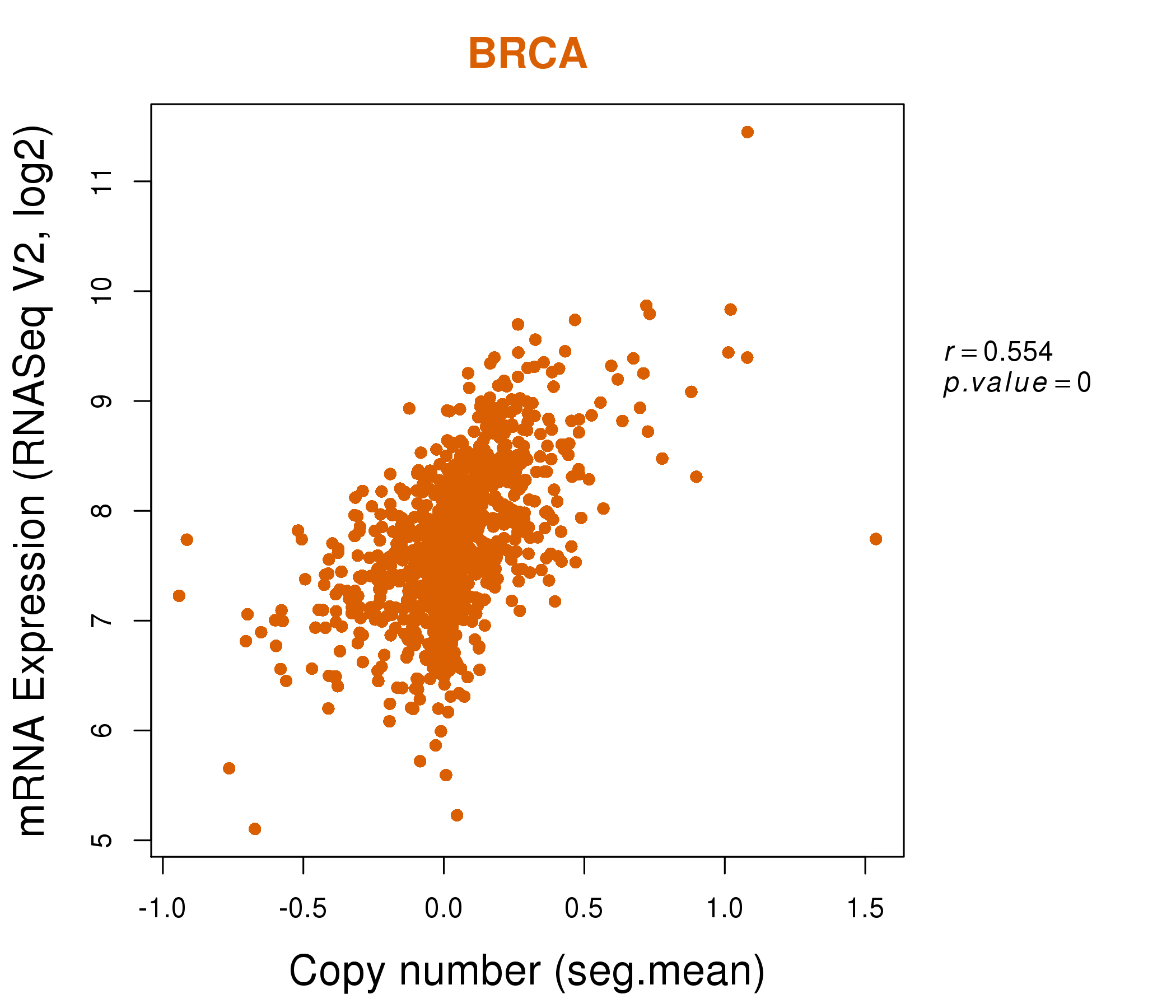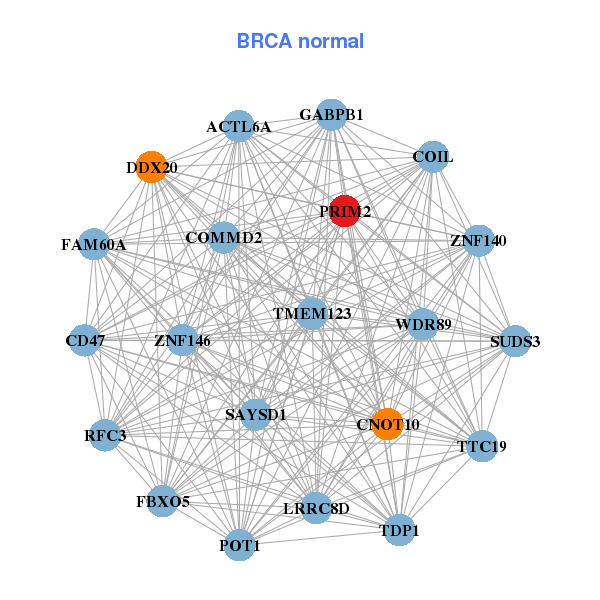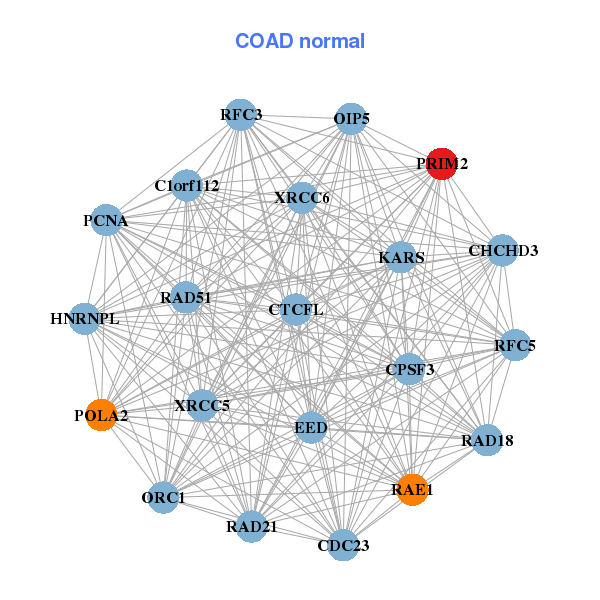|
|||||||||||||||||||||||||||||||||||||||||||||||||||||||||||||||||||||||||||||||||||||||||||||||||||||||||||||||||||||||||||||||||||||||||||||||||||||||||||||||||||||||||||||||||||||||||||||||||||||||||||||||||||||||||||||||||||||||||||||||||||||||||||||||||||||||||||||||||||||||||||||||||||||||||||||||||
| |
| Phenotypic Information (metabolism pathway, cancer, disease, phenome) |
| |
| |
| Gene-Gene Network Information: Co-Expression Network, Interacting Genes & KEGG |
| |
|
| Gene Summary for PRIM2 |
| Top |
| Phenotypic Information for PRIM2(metabolism pathway, cancer, disease, phenome) |
| Cancer | CGAP: PRIM2 |
| Familial Cancer Database: PRIM2 | |
| * This gene is included in those cancer gene databases. |
|
|
|
|
|
| . | |||||||||||||||||||||||||||||||||||||||||||||||||||||||||||||||||||||||||||||||||||||||||||||||||||||||||||||||||||||||||||||||||||||||||||||||||||||||||||||||||||||||||||||||||||||||||||||||||||||||||||||||||||||||||||||||||||||||||||||||||||||||||||||||||||||||||||||||||||||||||||||||||||||||||||
Oncogene 1 | Significant driver gene in | ||||||||||||||||||||||||||||||||||||||||||||||||||||||||||||||||||||||||||||||||||||||||||||||||||||||||||||||||||||||||||||||||||||||||||||||||||||||||||||||||||||||||||||||||||||||||||||||||||||||||||||||||||||||||||||||||||||||||||||||||||||||||||||||||||||||||||||||||||||||||||||||||||||||||||||||||
| cf) number; DB name 1 Oncogene; http://nar.oxfordjournals.org/content/35/suppl_1/D721.long, 2 Tumor Suppressor gene; https://bioinfo.uth.edu/TSGene/, 3 Cancer Gene Census; http://www.nature.com/nrc/journal/v4/n3/abs/nrc1299.html, 4 CancerGenes; http://nar.oxfordjournals.org/content/35/suppl_1/D721.long, 5 Network of Cancer Gene; http://ncg.kcl.ac.uk/index.php, 1Therapeutic Vulnerabilities in Cancer; http://cbio.mskcc.org/cancergenomics/statius/ |
| KEGG_PURINE_METABOLISM KEGG_PYRIMIDINE_METABOLISM | |
| OMIM | |
| Orphanet | |
| Disease | KEGG Disease: PRIM2 |
| MedGen: PRIM2 (Human Medical Genetics with Condition) | |
| ClinVar: PRIM2 | |
| Phenotype | MGI: PRIM2 (International Mouse Phenotyping Consortium) |
| PhenomicDB: PRIM2 | |
| Mutations for PRIM2 |
| * Under tables are showing count per each tissue to give us broad intuition about tissue specific mutation patterns.You can go to the detailed page for each mutation database's web site. |
| - Statistics for Tissue and Mutation type | Top |
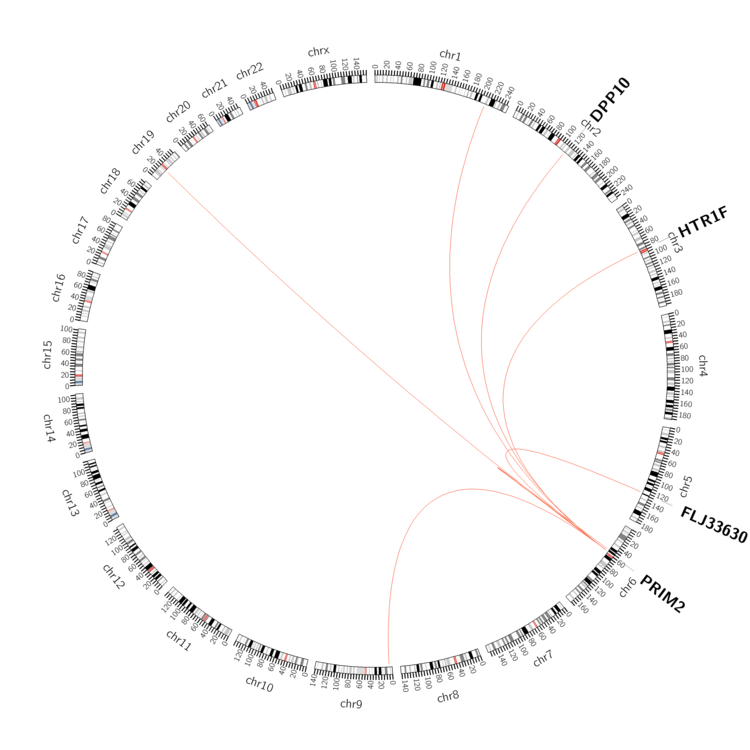 |
| - For Inter-chromosomal Variations |
| * Inter-chromosomal variantions includes 'interchromosomal amplicon to amplicon', 'interchromosomal amplicon to non-amplified dna', 'interchromosomal insertion', 'Interchromosomal unknown type'. |
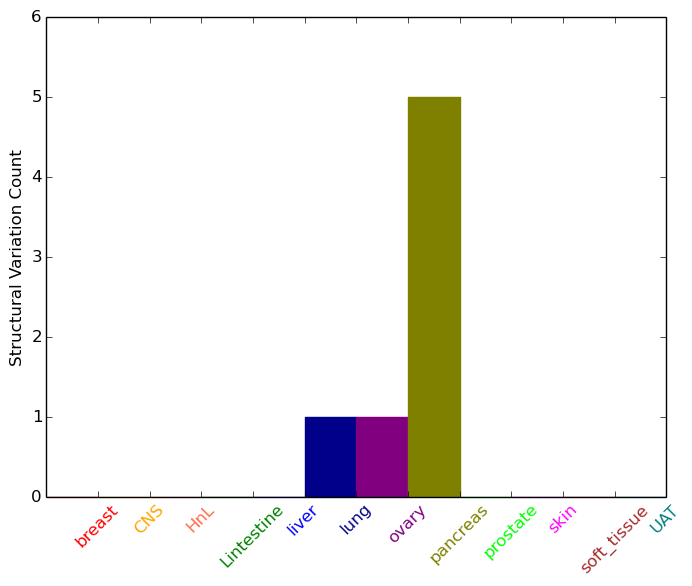 |
| - For Intra-chromosomal Variations |
| * Intra-chromosomal variantions includes 'intrachromosomal amplicon to amplicon', 'intrachromosomal amplicon to non-amplified dna', 'intrachromosomal deletion', 'intrachromosomal fold-back inversion', 'intrachromosomal inversion', 'intrachromosomal tandem duplication', 'Intrachromosomal unknown type', 'intrachromosomal with inverted orientation', 'intrachromosomal with non-inverted orientation'. |
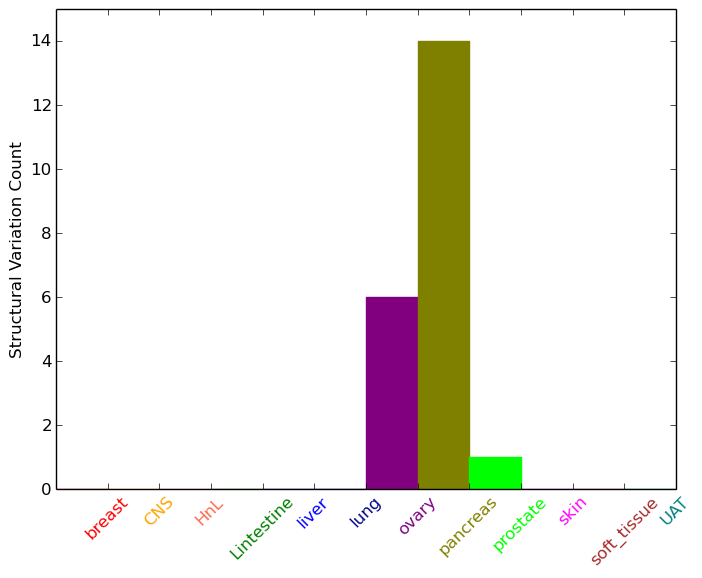 |
| Sample | Symbol_a | Chr_a | Start_a | End_a | Symbol_b | Chr_b | Start_b | End_b |
| ovary | PRIM2 | chr6 | 57359152 | 57359172 | PRIM2 | chr6 | 57371218 | 57371238 |
| ovary | PRIM2 | chr6 | 57386157 | 57386177 | PRIM2 | chr6 | 57388981 | 57389001 |
| ovary | PRIM2 | chr6 | 57386530 | 57386550 | PRIM2 | chr6 | 57386652 | 57386672 |
| ovary | PRIM2 | chr6 | 57392588 | 57392608 | chr6 | 54408038 | 54408058 | |
| ovary | PRIM2 | chr6 | 57400460 | 57400480 | PRIM2 | chr6 | 57400620 | 57400640 |
| pancreas | PRIM2 | chr6 | 57278207 | 57278227 | PRIM2 | chr6 | 57280991 | 57281011 |
| pancreas | PRIM2 | chr6 | 57297174 | 57297194 | PRIM2 | chr6 | 57301232 | 57301252 |
| pancreas | PRIM2 | chr6 | 57301331 | 57301351 | PRIM2 | chr6 | 57301484 | 57301504 |
| pancreas | PRIM2 | chr6 | 57308703 | 57308723 | chr9 | 6065724 | 6065744 | |
| pancreas | PRIM2 | chr6 | 57381855 | 57381875 | PRIM2 | chr6 | 57382089 | 57382109 |
| pancreas | PRIM2 | chr6 | 57389180 | 57389200 | PRIM2 | chr6 | 57390006 | 57390026 |
| pancreas | PRIM2 | chr6 | 57416935 | 57416955 | PRIM2 | chr6 | 57418569 | 57418589 |
| pancreas | PRIM2 | chr6 | 57443655 | 57443855 | PRIM2 | chr6 | 57425082 | 57425282 |
| pancreas | PRIM2 | chr6 | 57446962 | 57446982 | PRIM2 | chr6 | 57450002 | 57450022 |
| pancreas | PRIM2 | chr6 | 57472972 | 57472992 | PRIM2 | chr6 | 57493131 | 57493151 |
| pancreas | PRIM2 | chr6 | 57475899 | 57475919 | chr19 | 23220455 | 23220475 | |
| pancreas | PRIM2 | chr6 | 57481651 | 57481671 | PRIM2 | chr6 | 57481701 | 57481721 |
| pancreas | PRIM2 | chr6 | 57498119 | 57498139 | PRIM2 | chr6 | 57498218 | 57498238 |
| prostate | PRIM2 | chr6 | 57417457 | 57417457 | PRIM2 | chr6 | 57432834 | 57432834 |
| cf) Tissue number; Tissue name (1;Breast, 2;Central_nervous_system, 3;Haematopoietic_and_lymphoid_tissue, 4;Large_intestine, 5;Liver, 6;Lung, 7;Ovary, 8;Pancreas, 9;Prostate, 10;Skin, 11;Soft_tissue, 12;Upper_aerodigestive_tract) |
| * From mRNA Sanger sequences, Chitars2.0 arranged chimeric transcripts. This table shows PRIM2 related fusion information. |
| ID | Head Gene | Tail Gene | Accession | Gene_a | qStart_a | qEnd_a | Chromosome_a | tStart_a | tEnd_a | Gene_a | qStart_a | qEnd_a | Chromosome_a | tStart_a | tEnd_a |
| EB362401 | PRIM2 | 19 | 41 | 6 | 57340329 | 57340351 | CRYAB | 27 | 323 | 11 | 111779352 | 111779648 | |
| BQ345327 | ACP6 | 83 | 493 | 1 | 147119192 | 147119602 | PRIM2 | 487 | 563 | 6 | 57343288 | 57343364 | |
| Top |
| Mutation type/ Tissue ID | brca | cns | cerv | endome | haematopo | kidn | Lintest | liver | lung | ns | ovary | pancre | prost | skin | stoma | thyro | urina | |||
| Total # sample | 9 | 1 | 14 | 10 | 8 | 5 | 2 | |||||||||||||
| GAIN (# sample) | 8 | 1 | 9 | 10 | 8 | 5 | 2 | |||||||||||||
| LOSS (# sample) | 1 | 5 |
| cf) Tissue ID; Tissue type (1; Breast, 2; Central_nervous_system, 3; Cervix, 4; Endometrium, 5; Haematopoietic_and_lymphoid_tissue, 6; Kidney, 7; Large_intestine, 8; Liver, 9; Lung, 10; NS, 11; Ovary, 12; Pancreas, 13; Prostate, 14; Skin, 15; Stomach, 16; Thyroid, 17; Urinary_tract) |
| Top |
|
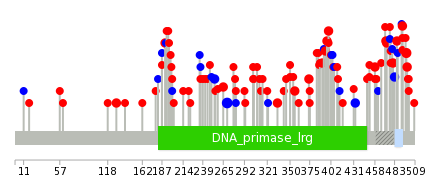 |
| Top |
| Stat. for Non-Synonymous SNVs (# total SNVs=89) | (# total SNVs=20) |
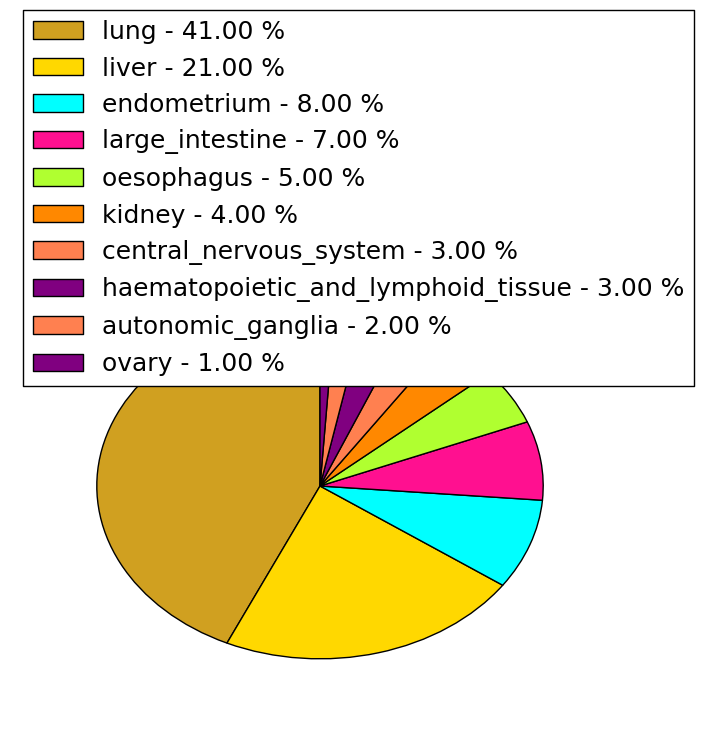 | 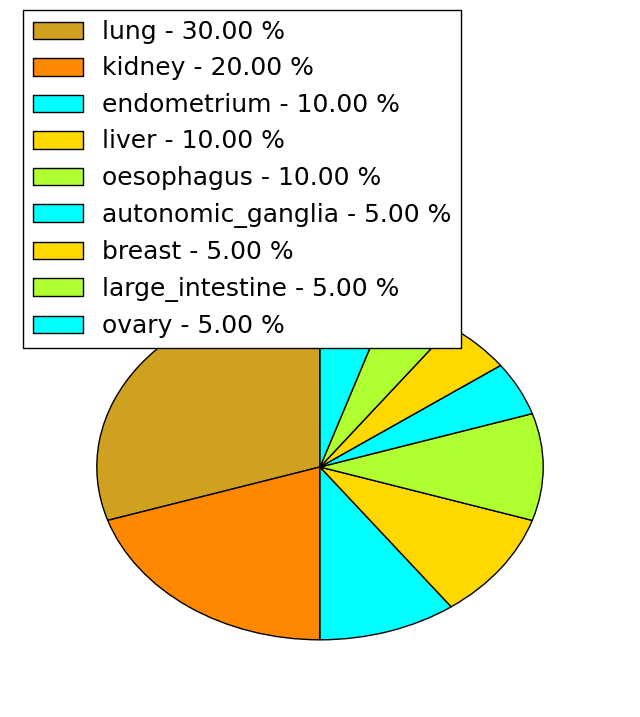 |
(# total SNVs=0) | (# total SNVs=0) |
| Top |
| * When you move the cursor on each content, you can see more deailed mutation information on the Tooltip. Those are primary_site,primary_histology,mutation(aa),pubmedID. |
| GRCh37 position | Mutation(aa) | Unique sampleID count |
| chr6:57512667-57512667 | p.E499* | 5 |
| chr6:57393160-57393160 | p.K270K | 4 |
| chr6:57398207-57398207 | p.G304* | 3 |
| chr6:57512650-57512650 | p.S493Y | 3 |
| chr6:57512666-57512666 | p.M498I | 3 |
| chr6:57512544-57512544 | p.G458R | 3 |
| chr6:57467180-57467180 | p.N374S | 2 |
| chr6:57512621-57512621 | p.A483A | 2 |
| chr6:57246844-57246844 | p.A191T | 2 |
| chr6:57246934-57246934 | p.E221K | 2 |
| Top |
|
 |
| Point Mutation/ Tissue ID | 1 | 2 | 3 | 4 | 5 | 6 | 7 | 8 | 9 | 10 | 11 | 12 | 13 | 14 | 15 | 16 | 17 | 18 | 19 | 20 |
| # sample | 1 | 1 | 2 | 1 | 2 | |||||||||||||||
| # mutation | 1 | 1 | 2 | 1 | 2 | |||||||||||||||
| nonsynonymous SNV | 1 | 1 | 1 | 1 | ||||||||||||||||
| synonymous SNV | 1 | 1 | 1 |
| cf) Tissue ID; Tissue type (1; BLCA[Bladder Urothelial Carcinoma], 2; BRCA[Breast invasive carcinoma], 3; CESC[Cervical squamous cell carcinoma and endocervical adenocarcinoma], 4; COAD[Colon adenocarcinoma], 5; GBM[Glioblastoma multiforme], 6; Glioma Low Grade, 7; HNSC[Head and Neck squamous cell carcinoma], 8; KICH[Kidney Chromophobe], 9; KIRC[Kidney renal clear cell carcinoma], 10; KIRP[Kidney renal papillary cell carcinoma], 11; LAML[Acute Myeloid Leukemia], 12; LUAD[Lung adenocarcinoma], 13; LUSC[Lung squamous cell carcinoma], 14; OV[Ovarian serous cystadenocarcinoma ], 15; PAAD[Pancreatic adenocarcinoma], 16; PRAD[Prostate adenocarcinoma], 17; SKCM[Skin Cutaneous Melanoma], 18:STAD[Stomach adenocarcinoma], 19:THCA[Thyroid carcinoma], 20:UCEC[Uterine Corpus Endometrial Carcinoma]) |
| Top |
| * We represented just top 10 SNVs. When you move the cursor on each content, you can see more deailed mutation information on the Tooltip. Those are primary_site, primary_histology, mutation(aa), pubmedID. |
| Genomic Position | Mutation(aa) | Unique sampleID count |
| chr6:57183296 | p.L11L,PRIM2 | 1 |
| chr6:57183306 | p.R18M,PRIM2 | 1 |
| chr6:57185271 | p.S21S,PRIM2 | 1 |
| chr6:57185282 | p.E57D,PRIM2 | 1 |
| chr6:57185310 | p.V61E,PRIM2 | 1 |
| chr6:57190736 | p.Y70Y,PRIM2 | 1 |
| chr6:57183276 | p.R118C,PRIM2 | 1 |
| * Copy number data were extracted from TCGA using R package TCGA-Assembler. The URLs of all public data files on TCGA DCC data server were gathered on Jan-05-2015. Function ProcessCNAData in TCGA-Assembler package was used to obtain gene-level copy number value which is calculated as the average copy number of the genomic region of a gene. |
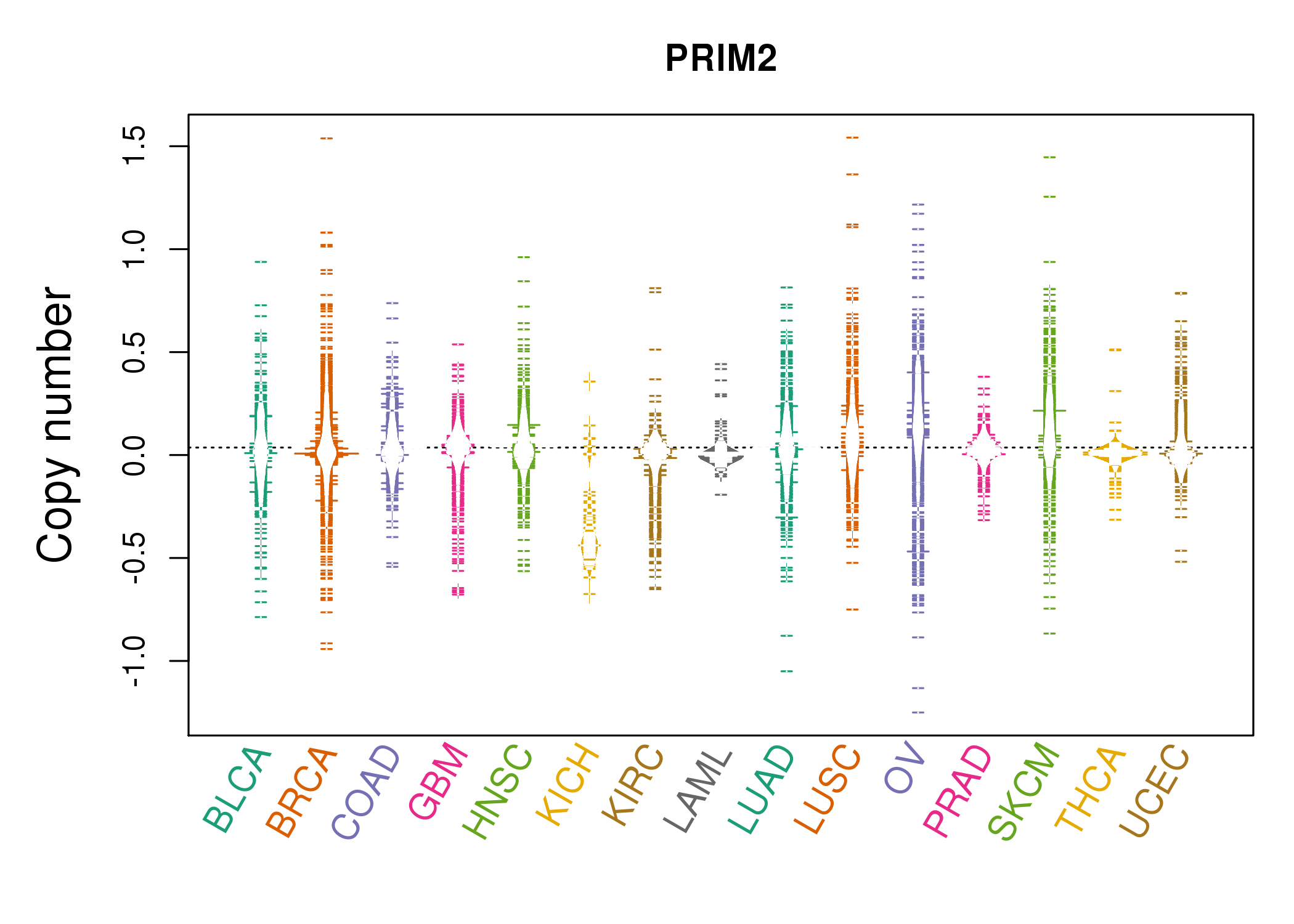 |
| cf) Tissue ID[Tissue type]: BLCA[Bladder Urothelial Carcinoma], BRCA[Breast invasive carcinoma], CESC[Cervical squamous cell carcinoma and endocervical adenocarcinoma], COAD[Colon adenocarcinoma], GBM[Glioblastoma multiforme], Glioma Low Grade, HNSC[Head and Neck squamous cell carcinoma], KICH[Kidney Chromophobe], KIRC[Kidney renal clear cell carcinoma], KIRP[Kidney renal papillary cell carcinoma], LAML[Acute Myeloid Leukemia], LUAD[Lung adenocarcinoma], LUSC[Lung squamous cell carcinoma], OV[Ovarian serous cystadenocarcinoma ], PAAD[Pancreatic adenocarcinoma], PRAD[Prostate adenocarcinoma], SKCM[Skin Cutaneous Melanoma], STAD[Stomach adenocarcinoma], THCA[Thyroid carcinoma], UCEC[Uterine Corpus Endometrial Carcinoma] |
| Top |
| Gene Expression for PRIM2 |
| * CCLE gene expression data were extracted from CCLE_Expression_Entrez_2012-10-18.res: Gene-centric RMA-normalized mRNA expression data. |
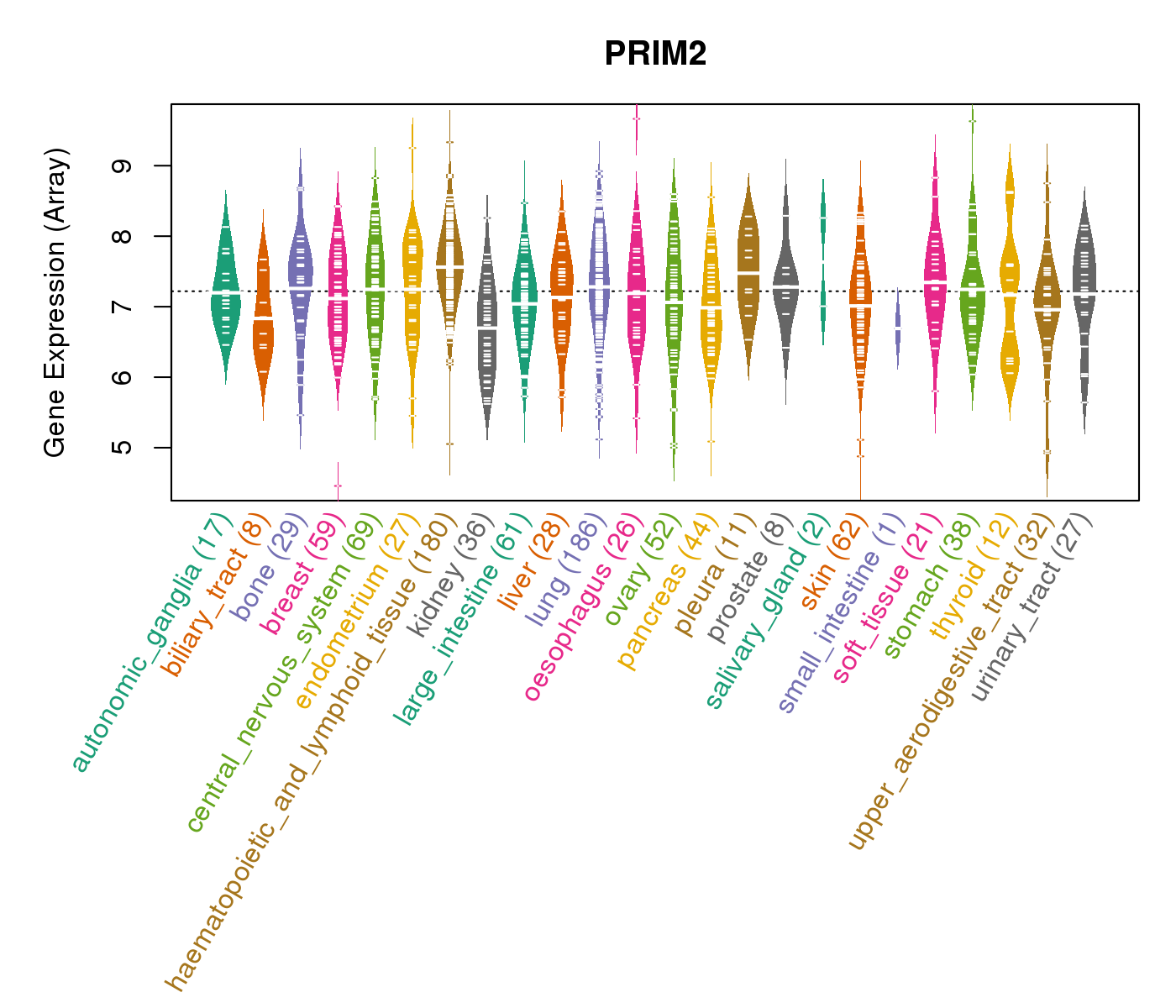 |
| * Normalized gene expression data of RNASeqV2 was extracted from TCGA using R package TCGA-Assembler. The URLs of all public data files on TCGA DCC data server were gathered at Jan-05-2015. Only eight cancer types have enough normal control samples for differential expression analysis. (t test, adjusted p<0.05 (using Benjamini-Hochberg FDR)) |
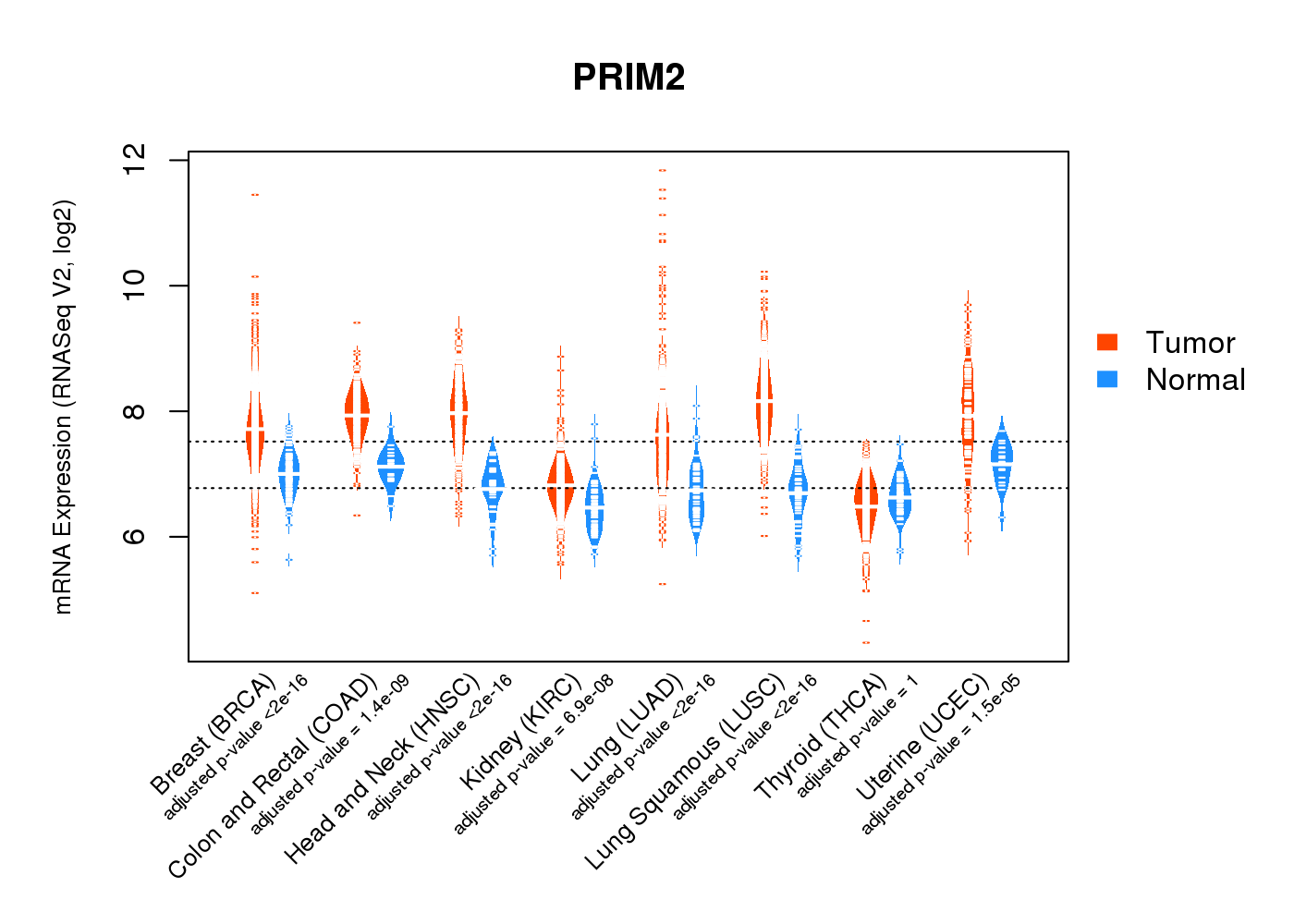 |
| Top |
| * This plots show the correlation between CNV and gene expression. |
: Open all plots for all cancer types
 |
|
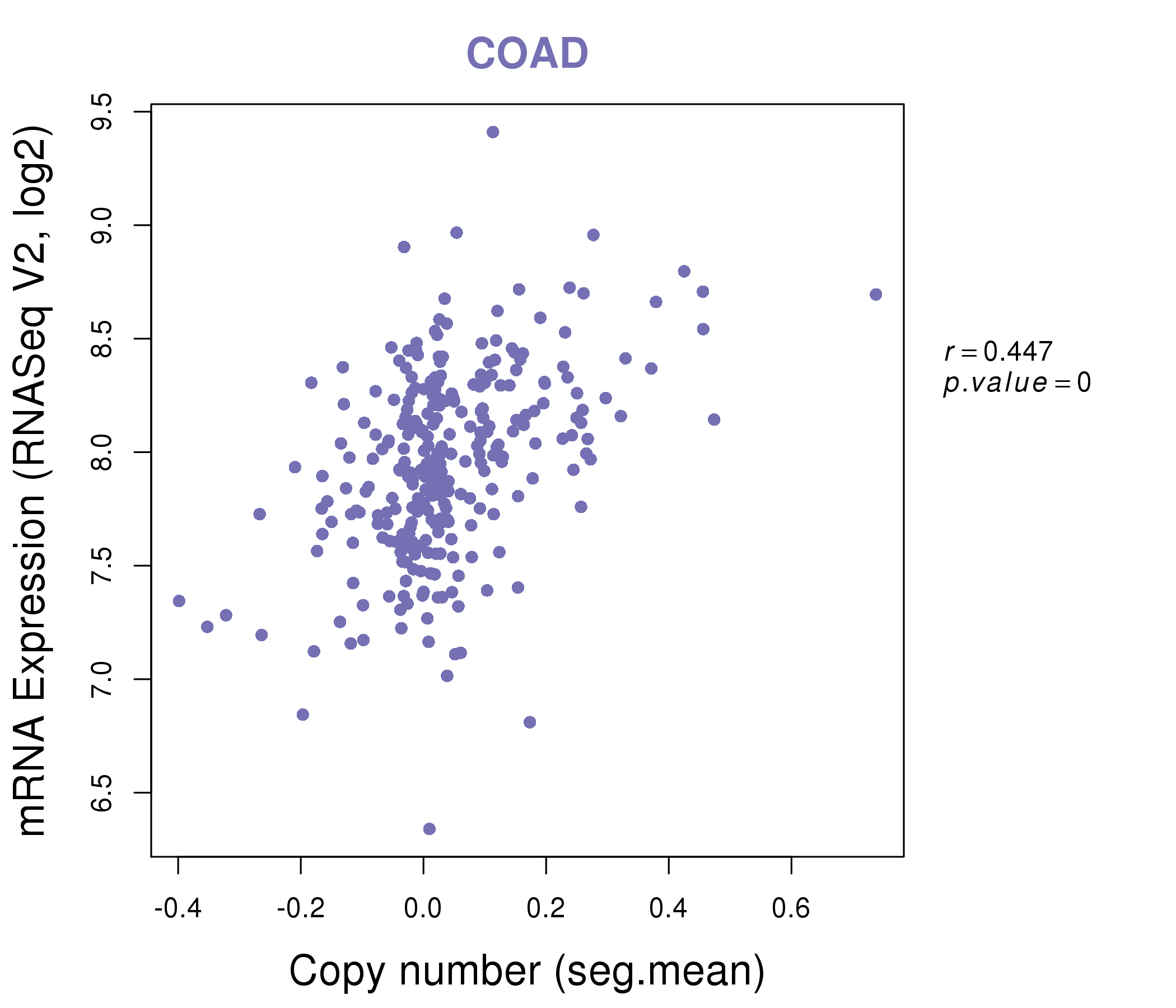 |
|
| Top |
| Gene-Gene Network Information |
| * Co-Expression network figures were drawn using R package igraph. Only the top 20 genes with the highest correlations were shown. Red circle: input gene, orange circle: cell metabolism gene, sky circle: other gene |
: Open all plots for all cancer types
 |
|
| BUB1,CEP55,DEK,EXO1,GMPS,KIF11,KIF18A, KIF20A,KIF23,KIF4A,KIFC1,MCM3,MELK,MKI67, NCAPH,PRIM2,SRPK1,STIL,SYNCRIP,TPX2,TTK | ACTL6A,SAYSD1,CD47,CNOT10,COIL,COMMD2,DDX20, FAM60A,FBXO5,GABPB1,LRRC8D,POT1,PRIM2,RFC3, SUDS3,TDP1,TMEM123,TTC19,WDR89,ZNF140,ZNF146 |
 |
|
| ACTL6A,CMSS1,CENPQ,CIRH1A,MTFR2,FBXO5,GLO1, PAK1IP1,PEX3,PPIL1,PRIM1,PRIM2,RFC4,RNASEH2A, SRSF3,SRSF7,SNRPC,SPC25,TCP1,TTK,USP39 | C1orf112,CDC23,CHCHD3,CPSF3,CTCFL,EED,HNRNPL, KARS,OIP5,ORC1,PCNA,POLA2,PRIM2,RAD18, RAD21,RAD51,RAE1,RFC3,RFC5,XRCC5,XRCC6 |
| * Co-Expression network figures were drawn using R package igraph. Only the top 20 genes with the highest correlations were shown. Red circle: input gene, orange circle: cell metabolism gene, sky circle: other gene |
: Open all plots for all cancer types
| Top |
: Open all interacting genes' information including KEGG pathway for all interacting genes from DAVID
| Top |
| Pharmacological Information for PRIM2 |
| There's no related Drug. |
| Top |
| Cross referenced IDs for PRIM2 |
| * We obtained these cross-references from Uniprot database. It covers 150 different DBs, 18 categories. http://www.uniprot.org/help/cross_references_section |
: Open all cross reference information
|
Copyright © 2016-Present - The Univsersity of Texas Health Science Center at Houston @ |






